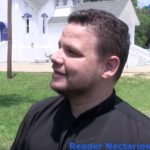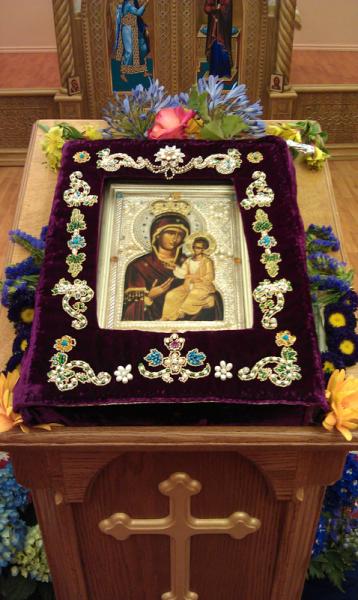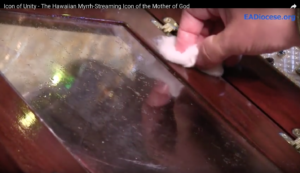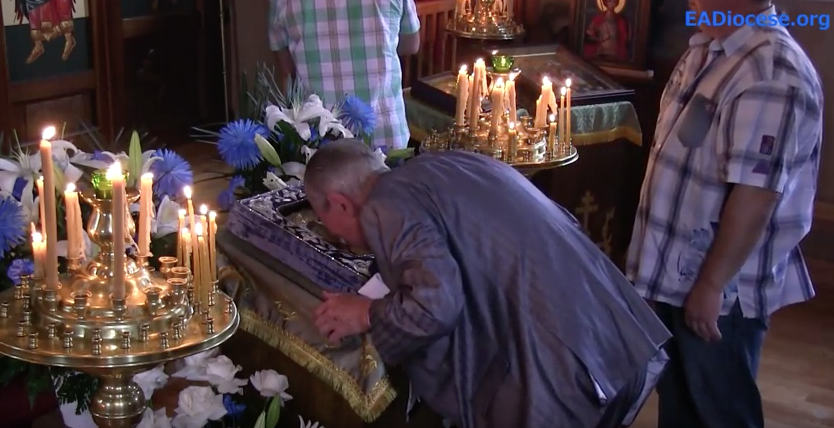Recently, there has been an increase in dialogue between Reformed Christians and Orthodox Christians about icons. Much of it has been of an intellectual nature focused on the Bible and the early church fathers, but what is one to make of miraculous icons? These pose a different kind of challenge to Christians who are accustomed to using logic and reason in theological debates.
I just received this from one of our readers, JM Burnham, who wrote of his encounter with miraculous icon in June 2016:
This past Sunday in my parish church, Holy Apostles (ROCOR) in Beltsville, Maryland, we had the distinct honor of welcoming the Hawaiian Iveron Myrrh-streaming Icon. As our dear Metropolitan Hilarion (First Hierarch of the Russian Church Abroad) was celebrating the Divine Liturgy, everyone came up to the Icons of the church-temple and venerated them. The myrrh-streaming Icon, which I named above, was actually streaming myrrh and giving off one of the loveliest odours of holiness I had ever witnessed; i.e., like roses mixed with a myriad of other odorous flowers, but a hundred times more fragrant and soothing.
Having said that, I have sadly encountered several [D]eformed Protestants who said that “It’s nothing more than Devil’s work! Satan’s deceiving you to get you to worship your idols and forget about Jesus!” Instead of taking it upon themselves to investigate further, I’ve noticed that such persons immediately dismiss any miracles in the Orthodox Church (let alone actively myrrh-streaming icons) as trickery from the Evil One. They then point their fingers at us Orthodox Christians saying that we’re guilty of idol worship and so many other “sins” against God. It is well-known that many Protestants, even some traditionalist Roman Catholics, don’t even believe that we Orthodox are actually Christians – but that’s a topic for another discussion.
The main point I’m trying to convey is anecdotal, yet strongly grounded in existential reality and interpersonal experience. For me, I felt confirmed in my faith as an Orthodox Christian. Seeing this miraculous icon actually helped me to realize some very important realities that I had been taking for granted, but not appreciating as deeply as I ought:
Icons are not “idolatrous pictures of dead saints,” as most mainline Protestants would call them. These sacred “pictures” amplify, and bring home the reality of, the Incarnation of the God-man, Jesus Christ. In particular, myrrh-streaming icons, such as the Hawaiian Iveron Icon as aforementioned, demonstrate the approval of the Holy Spirit, for it is only the Holy Spirit Who could bring about such secular-logic-defying, clearly supernatural occurrences. It is almost always (about 95% of the time) Icons of the Theotokos that tend to be miraculous. This demonstrates Mary’s critical role in God the Word’s [historical] Incarnation as well as the incarnational reality of the Church, Christ’s Mystical Body; after all, the Church Fathers looked upon Mary as the purest figure of the Church. Moreover, after venerating the myrrh-streaming icon, I realized in a more profound way that the Orthodox Church truly is the Body of Christ, in both time and eternity, in heaven and on earth, against which “the gates of hell shall [have] not prevail[ed]” (Matthew 16:18).
I just wanted to share this little story with everyone to help bring home the profoundly simple truth of the Orthodox Faith concerning Icons. As a side note, I’m a recovering Roman Catholic, and I sometimes still struggle with some of the negatives effects that Roman Catholic heresy has had upon my heart, mind, body, and soul. Such miraculous icons can only be witnessed in canonical Orthodox Churches. They do NOT exist in the Roman Catholic church or in the Protestant communities; moreover, they definitely do not exist in any other religious expression (non-Christian) known to mankind. Orthodoxy is indeed unique; it is deeply supernatural and a living Faith that has no equals.
Comment from Robert
I know this icon. Living in Hawaii, I visit the Russian Orthodox Church often and most of the time I will see this icon on the stand up in front. The icon is what I would call a quiet miracle. When I stand before it, I can see oily streaks on the glass cover and smell the flowery fragrance emanating from the icon. The first time I saw the icon I was surprised by the absence of drama. Yet, as I stood before it, I found myself amazed at this inexplicable phenomenon. It was as if God opened this window to heaven just a tiny bit, allowing the fragrant scent of heaven to flow over into our fallen world that is so desperately in need of His mercy.
There are stories of people being healed miraculously after being anointed by the oil coming from this icon. But then, there are many who have not been healed after seeing this icon. These healing miracles are a gift from God, but they are not the main point. With respect to miracles, Orthodoxy is not cessationist. (Cessationaism is the heresy that miracles ceased with the death of the last of the original Apostles.) We believe that miracles can happen, even today. The main point of Orthodox icons is to draw us closer to Christ. When I stand before the miraculous Iveron icon, I see the Virgin Mary pointing her hand to Jesus. I am reminded of her total commitment to her Son and our God. I reflect on her words: “Whatever He says to you, do it.” (John 2:5)
I would not advocate using miraculous icons as a means of refuting the Reformed tradition’s iconoclasm. The better approach is to appeal to Scripture and the witness of the church fathers. Nonetheless, the miraculous Hawaiian icon does pose a challenge to the secular, disenchanted worldview so prevalent among Reformed and Evangelical Christians. Fr. Stephen Freeman described this particular outlook in his recent post “The Disenchanted World”:
Where people of earlier eras and other cultures have experienced the world around them as charged with divine power (of various sorts), we simply experience the world as inert. There is nothing there.
Secularism has affected, not just the way Protestants view nature, but also the way they approach conversion. The Protestant reduction of the Gospel to mere “rational choice” avoids, if not obviates, conversion being a super-natural work of the Holy Spirit. The empirical nature of this miraculous icon cannot be refuted by means of logic and syllogism.
 Reader Nectarios Yangson who is tasked with guarding the icon noted:
Reader Nectarios Yangson who is tasked with guarding the icon noted:
It is the grace of the Holy Spirit visibly showing itself upon us. It is something tangible: we can touch; we can taste; we can feel. [See “Icon of Unity” at 7:25]
An encounter with the Hawaiian miraculous icon and others like it – Yes, there are other miraculous icons! – is like a short visit to the enchanted world of the kingdom of God suffused with the divine presence.
In the Bible, visible tangible miracles are often used to validate a spiritual claim. In Mark’s Gospel Jesus prefaced the healing of the paralytic with: “But that you may know . . . .” (Mark 2:10) The beneficiaries of the healing miracle were not just the paralytic lying on the pallet, but also the Pharisees and teachers of the Law who doubted Jesus’ authority to forgive sins. Not all miracles are from God; therefore, miracles need to be subjected to spiritual tests, e.g., Is Jesus Christ glorified? Is his coming in the flesh affirmed? Is the Church, the Body of Christ, edified? Are sinners converted? The atmosphere surrounding a miraculous icon should be a faith-filled one like in Luke 5:26: “And they were all amazed, and they glorified God and were filled with fear, saying, ‘We have seen strange things today!’”
Miraculous icons also serve as notice to prospective converts that conversion to Orthodoxy entails more than an intellectual acceptance of the Seventh Ecumenical Council and the writings of early church fathers like John of Damascus and Theodore the Studite. It involves a transition from a detached, intellectual approach to Christianity to one of an embodied mysticism that is sensuous and otherworldly at the same time. One does not gawk at a miraculous icon. The Orthodox response to this miraculous icon is one of veneration mixed with love and affection. We gather at church; we sing hymns honoring Mary; we ask Mary to be our prayer partner to Christ; and we line up to kiss her icon. This is what the Seventh Ecumenical Council had in mind when they affirmed the veneration of icons. One way to venerate the Hawaii Iveron icon is to kiss Mary’s hand which points to her Son and then to kiss Christ’s feet. In honoring the mother we honor her Son, and in honoring our God Jesus Christ we honor his mother Mary who made possible the miracle of the Incarnation.
A friend once expressed disappointment that she had missed seeing the miraculous icon. I pointed out that all icons are special, and, that this miraculous is not more sacred than the others. It is just that God chose to use this particular icon to manifest his grace in a visible, tangible way to weak, sinful people like us. With the other “ordinary” icons God’s grace is invisible; we respond to this unseen grace through an act of faith. This means we don’t have wait for a miraculous icon to come to our neighborhood. Just go to the nearest Orthodox parish!
In closing, the miraculous Hawaii icon is a sign that the kingdom of God has come near, that we need to repent and turn to God. This call to repentance applies to the Orthodox just as it does to Reformed and Evangelical Christians. So if the Hawaiian miraculous icon does come to your area, don’t hesitate to visit the icon. It is God’s gift of mercy to Orthodox and non-Orthodox. As Philip said in response to Nathaniel’s skepticism: “Come and see!”
Robert Arakaki
RESOURCES
Article: “Iveron Icon of the Blessed Virgin Mary Visits Our Assumption of the Blessed Virgin Mary Church.”
Video: “Icon of Unity – The Hawaiian Myrrh-Streaming Icon of the Mother of God.” [Reader Nectarios at 7:25]
Video: NECN News Report “‘exuding’ icon draws thousands to Massachusetts.”
Video: “Opening Hawaii Icon”
Article: “The Disenchanted World.” Fr. Stephen Freeman. Glory to God for All Things, 22 July 2016.



We had an encounter with the oil of the icon, my daughter had a rash all over her upper body and we annoited her with it and within a few minutes the itching was gone and the next day the rash was gone.
This Icon and the oil challenges the iconoclasm which is prevalent in my life (not sure if it’s all over the US) people hear of these things happening and see the Bible come to life ex. Paul’s neckerchief.
Travis, Thank you for sharing!
Robert
There was a case here in the Central Valley of California similar to the story told.
A catholic mother from Mexico lost her son in an Auto Accident. She made a small memorial in her home with candles, pictures of her son, Jesus picture and a statue of Mary. It was in our Local news that is why I can describe it. The statue of Mary would from time to time, not always, occasionally drip a oily substance with a sweet aroma or scent. It showed the drip, or sweat from Mary’s face in the news. A dish was placed underneath for visitors. She had quit a few after it made the local news. I don’t remember what the scientific explanation they gave, because I was not catholic and so it did not interest me all that much.
It also reminded me of a Newspaper report in my childhood back home in Germany with a similar happening, though it was blood running from the side of a Jesus statue (where he was pierced by a Roman according to scripture). It was in the Shop of our devout Catholic Shoemaker. The shop was closed then, but I never forget it….and we never brought our Shoes in again…. scared to death as a 10 year old. We don’t know what happened, but the shop never opened after that.
Glory to God! My first experience at our beloved Life Giving Spring Monastery in Dunlap, CA was during a visit of this miraculous icon. Since then it has visited our parish a couple of times, and my family was blessed with a small vial. Without fail, each time I think it will run out, it seems to regenerate enough for a blessing.
Thank you for sharing!
Anthony, I looked up this monastery in Dunlap on line and what a magnificent and beautiful place it is from the pictures. I wonder if the Cathedral is open for visitors at all times, because I would love to see it as it is only about 1 1/2 hour drive from where I live. It would make a beautiful drive on a Sunday afternoon or morning. Looks like driving to a Holy City. 🙂
I’ve seen the Hawaiian icon 3x, and each time, I hoped for healing for myself and nothing happened. I took my oil home on a cotton ball in a baggie. Last time I saw the icon was last August 15th of last year. This last week, my 91 year old grandma had a freak accident. Her dashound, Molly, was trying to protect her and chased after a man. My grandma had the leash around her wrist and was dragged downhill into a tree. She laid there knocked out for 30 minutes. She was admitted into the hospital. She broke her shoulder, both bones in her forearm, her pelvis and her ribs. In the hospital, she got pnuemonia and her kidneys began to fail. The doctor gave her a week to live. Family flew in from New Mexico and Southern California to say goodbye. I remembered the oil. The cotton looked dry, but to my surprise, touched, it was oily and fragrant with roses. I grabbed a swab and took some with me. When I arrived, my Aunt said they had to have all the flowers removed from the room and that grandma was deathly allergic to perfume and flowers. So, here I am, wanting to annoint her with the myrrh that smells like rose, and am disappointed. A couple hours later I check my baggie and…NO SMELL. Knowing that was a miracle, I had to find a way to annoint her. (My family is protestant, but they all love Jesus.). So, I figured if I went to lunch, I could dip my finger and hold her hand with it before I go. She had been minimally responsive to this point. She grabbed my hand and brought it to her forehead…so I annointed that too. I went to lunch. When I came back, she was sitting up, chatting away with family and even making jokes and recognised me by name (unaware I had been there for 2 days).
Part of me was grateful for even just responsiveness as a mircle before she died, so family could have a moment with her. However, the next day…Pnumonia gone. Kidneys functioning. A few days later, she has been released into convelencent care. Her bones still need to heal, but glory to God, for his mercy for my Grandma, who is not Orthodox, but is a stong godfearing southern woman who takes her bible seriously and loves the Lord. I told a few people of what I did in my family. Who knows how God will use it? It will be intersting to see how this unfolds. Oh, and when I got to my cousin’s house…the scent of roses came back…just after I told her what I had done. Glory to God. I was not the one in need of a miracle, but when I annointed her, it was the kind of love that was unselfish…I did it for her and my family. I was ready to say goodbye, but what an awful way to go…dragged by a weiner dog at 91. Also, so many family members could not afford the trip, including my mom2 in Arizona. My prayers were soley for them. When I got the news that my prayers were answered, I burst into tears, because, I’m a sinful nobody. Half the time, I can barely claim to be Orthodox, as I can barely get my act together to take communion. Anyway, Glory to God for His mercy, and for listening to the Theotokos intercession through this miraculous icon.
Glory to God! Thank you for sharing about your grandmother. May this incident bring all of us closer to Christ. And to his mom the Theotokos.
Robert
Genevieve,
Thank you for sharing this. God bless you, your grandmother and your entire family.
I need to tell you that your story has touched me deeply. I am an inquirer into Orthodoxy who was formerly Protestant. So far Orthodoxy has already blessed me greatly even in this phase, but there are some things that just naturally “freak me out” as a result of my background. Miraculous icons would be a good example. But when I read this story, I realized you were like the woman with a discharge of blood to whom Christ said, “Your faith has made you well.” I should not allow my skeptical nature to color my view of everything. Rather, I should simply being pleased at God’s grace in the world and the faith it inspires. Formerly, I was too worried about supposed “idolatry” to see the grace God can bring into the world through physical means. I see now more than ever that these means do not distract you from God, but bring you closer to them. I have no need to fear breaking the 2nd Commandment. Thank you so much for sharing this act of love and faith and how God has blessed you.
Hello Talia, I know your feelings, since I grew up at times Presbyterian and Protestant (Baptist) and other times atheist, and recently converted to RCC (first the ordinary one, then a “traditionalist” one). I had never really considered the Orthodox Church at all (after all, I’m not Russian or Greek!) but having heard of healings in all three “branches” of Christianity, nothing surprises me anymore. I know that generally Protestants are quick to blame Satan for everything, which is concerning since that’s what the Pharisees did! It’s taken me almost 2 years to learn about Roman Catholicism and it will take less time to learn about the Orthodox Church. God can use whatever He chooses, right?
Just last week this miraculous icon graced our parish in Boise, Idaho. What a quiet miracle indeed. Glory to God!
Ulrich Zwingli: “The more the honor and love of Christ increases among men, so much the esteem and honor given to Mary should grow.”
(Ulrich Zwingli, Zwingli Opera, Corpus Reformatorum, Volume 1, 424.)
Martin Luther: “The veneration of Mary is inscribed in the very depths of the human heart.” (Sermon, September 1, 1522).
“[She is the] highest woman and the noblest gem in Christianity after Christ . . . She is nobility, wisdom, and holiness personified. We can never honor her enough.”
My comment is offered as a Protestant converting to Orthodoxy.
Mr. Burnham says, “I felt confirmed in my faith as an Orthodox Christian. Seeing this miraculous icon actually helped me to realize some very important realities…” To this very point, Protestants have ingrained in their thinking the words of the Apostle Paul in 2 Cor. 5:7: “For we walk by faith, not by sight.”
There is, as the writing above reveals, an overt desire to want the miraculous icon to be real. This does not help the Protestant. Circumstantial experience as a defense of the matter does not make it true.
When Protestants hear of these things, they want to know: is there actual myrrh or some other fragrant resin in the frame, that simply seeps out naturally? Western thought wants the variables removed as a matter of fact. Therefore, Orthodox Christians should “always being ready to make a defense to everyone who asks you to give an account for the hope that is in you, yet with gentleness and reverence” (1 Peter 3:15), and state the truthful facts that silence the objectors so that all that is left is faith.
If, at that point, the Protestants want to invoke the matter as a work of Satan, then let them run the risk of blasphemy on their own.
David,
I appreciate your joining the conversation here on this blog. For many Protestants making the transition to Orthodoxy is fraught with many difficult questions. Your example of the question as to whether it was actual myrrh being exuded is a good one. I remember a Protest friend of mine asking whether the icon was on wood, stone, or metal. She noted that with stone or metal it would be much more difficult to create a miraculous icon. I was bemused by her skepticism and at the same time sympathetic. God bless you as you journey to Orthodoxy!
Robert
Actually I believe there is a protocol for addressing the issues miraculous icons present. First the icon is approached and Satan s rebuked, then it is checked physically to see if it is faked.
One of the most documented weeping icons is the one of the Thetokos on the iconostasis of St. George in Cicero, Il. It began weeping in 1994 and continued weeping for six months. My Bishop was the first hieraech to approach it and he rebuked Satan and it was investigated throughly before Met. Philip if blessed memory officially declared it a miracle.
If you go to the parish website http://www.stgeorgechi.org there is both a written history and a video interview with the priest 20 years after the icon wept.
Weeping icons are not unusual in the Orthodox Church. Each is a miracle though. Of particular note concerning the Cicero icon is that she alone survived a devastating fire that totally destroyed the rest of the parish. Her icon escaped totally unscathed. Without mark or blemish.
How or why these miracles occur only God knows, but they do occur and they are of God.